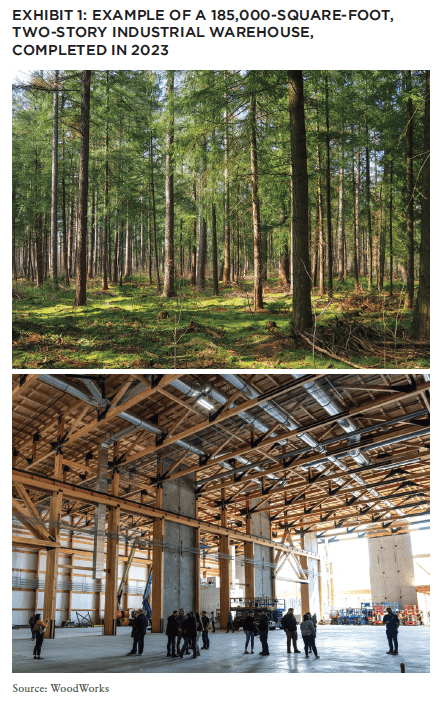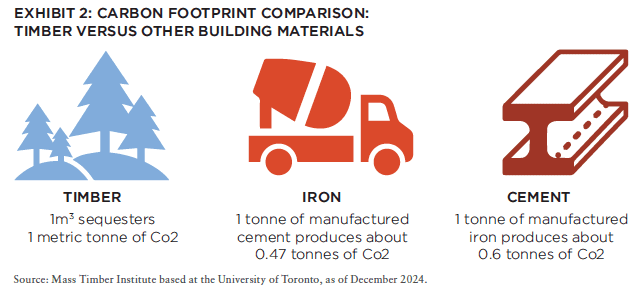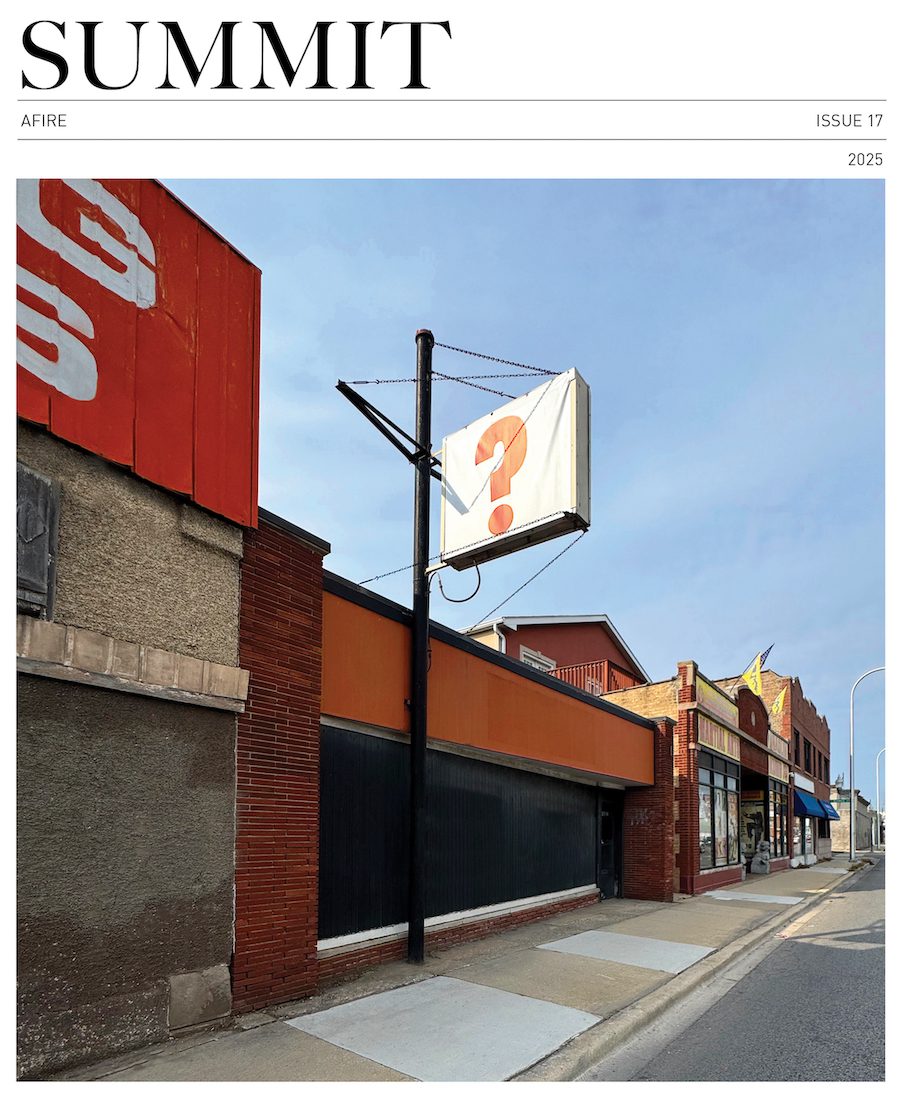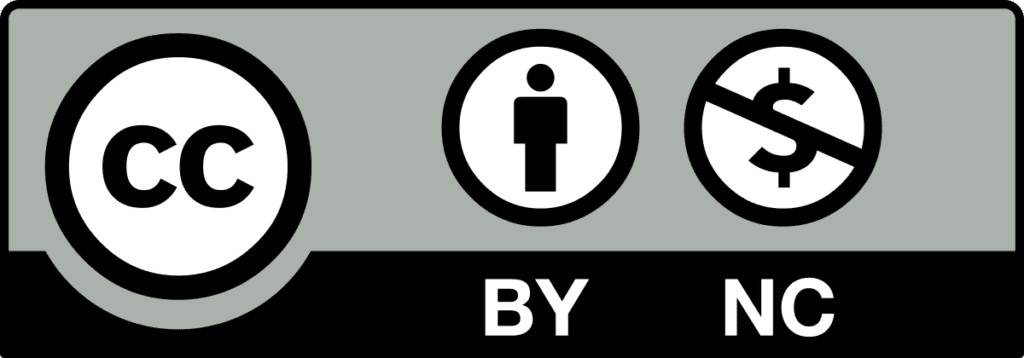Already leveraged for other commercial real estate asset types, mass timber has the potential to revolutionize industrial real estate development by offering sustainable, durable, and efficient construction solutions.
With its alignment to corporate environmental, social, and governance (ESG) goals and positive environmental impact, this article outlines how mass timber can represent an innovative pathway for modern and future construction and development in the industrial real estate sector.
THE RISE OF MASS TIMBER AND INDUSTRIAL REAL ESTATE
After a long century of steel and concrete construction dominance, mass timber construction innovation has emerged as a revolutionary construction method, with proven load-bearing capabilities and ability to be used in various applications beyond traditional wood construction.
Its strength and durability, superior fire rating, usability across spans/grids, and speed of construction make it suitable for large-scale commercial real estate, including multi-story offices, industrial warehouses, and even military bases.
Mass timber components are prefabricated and can be manufactured offsite, reducing construction timelines, cutting labor costs and minimizing on-site disruptions. Moreover, it offers a sustainable alternative to conventional materials like steel and concrete, which have significant environmental footprints.

The mass timber market is experiencing rapid growth, driven by advancements in technology, acceptance in regional building codes, and a growing emphasis on sustainable building practices. Unlike traditional lumber, mass timber products are created by bonding multiple layers of wood together to form large, structural components.
Innovations in cross-laminated timber (CLT), glue-laminated timber (glulam), and other engineered wood products have made mass timber a viable option for a wide range of applications.
Mass timber also boasts construction safety and reliability, helping to improve lender confidence in financing mass timber projects, furthering the adoption of mass timber by developers and also boosting investor support.
As of September 2024, there were 2,253 mass timber buildings in progress or completed in the US, including a growing number of factory/industrial projects.[1] These projects are concentrated along the coasts, with Washington, Oregon, California, and Massachusetts accounting for more than half of all projects since 2013, but adoption is spreading to Texas, Colorado, and Illinois.[2]
While mass timber is predominantly used in residential and office construction today, it has a growing potential for applications in other construction. Industrial, in particular, is a natural extension for developers, partly due to the recognized economic and environmental benefits of mass timber construction, and partly due to the reality that the sector is challenged by aging stock and the need to develop more nimble, state-of-the-art buildings.
E-commerce infiltration into the industrial real estate sector, coupled with supply chain reconfiguration, is shifting the way industrial properties are used, triggering major pivots in the specifications of industrial stock.
Tenants are seeking newer, state-of-the-art facilities that can accommodate technological innovation in the management, storage, and distribution of goods. Unsurprisingly, tenants are increasingly exiting older facilities in favor of more advanced ones, enabling footprint efficiency and consolidation in many instances. Nearly 50% of leases executed in the second quarter of this year were for Class A space, indicating a strong preference for high-quality, advanced facilities.[3]
Over the last decade, the industrial tenant base has become more dominated by large multi-national corporations, many with corporate strategies and initiatives driving occupiers to make real estate leasing decisions through an ESG lens; considering environmental sustainability, employee wellbeing, and satisfaction, and talent retention.
As industrial real estate developers look to meet the demand for state-of-the-art buildings, and the construction industry responds to investors’ desire to achieve carbon-reduction goals, sustainable designs are incorporating wood as the building material.
THE CONVERGENCE OF MASS TIMBER AND INDUSTRIAL REAL ESTATE
As a relatively new design and construction concept in the United States, mass timber use within industrial real estate has a few notable use cases, and an accompanying set of viability and benefits, including:
Economic volatility and emphasis on ESG within real estate, along with the critical need to make the most economical design decisions, may lead to increased adoption of mass timber construction for industrial development, especially for multi-story warehouses and urban logistics hubs where land is limited.
As the technology and production techniques for mass timber mature, economies of scale can make mass timber increasingly cost-effective compared to steel and concrete. Coupled with the inflationary and supply chain issues that have pushed input prices for new warehouse construction up 44% over the last five years, as measured by the producer price index, mass timber could become the preferred choice in terms of cost and sustainability.[4]
The use of mass timber in industrial construction is projected to grow by around 8% annually over the next decade, driven by increasing acceptance and cost competitiveness.[5] Cross-laminated timber consumption in North America is expected to grow more than 40% annually, compared to 15% in the EU through 2027, indicating rising demand for timber products and benefiting both forestry and construction industries.[6]
INDUSTRIAL PROJECTS FEATURING MASS TIMBER
- An aerospace manufacturer integrated mass timber into their 185,000-square-foot, two-story industrial warehouse completed in 2023. Steel delays catalyzed the use of mass timber, providing both speed and sustainability. The supplier provided 2.215 million board feet of lumber and manufactured the necessary glulam beams, columns, and CLT and GLT panels for the attached office, completing the project within eighteen months. The trees used for the mass timber components were sustainably harvested from Pacific Northwest forests.[7]
- A 28,000-square-foot high-density library storage facility, completed in 2018, is the first in Arkansas and the first in middle America to use CLT structural systems. Originally designed as a concrete block building, the switch to a mass timber frame and CLT walls saved taxpayers $1.1 million. Sourced from sustainably harvested local timberlands, the project achieved LEED gold certification and won an AIA Arkansas Honors Award in 2019.[8]
CONSTRUCTION CONSIDERATIONS
The development of mass timber projects is still limited in acceptance within the network of lenders, investors, contractors, and subcontractors, given specialized knowledge required to implement, a lack of data and case studies, and a nascent supply chain. This type of construction requires extensive up-front planning, involving mechanical, electrical, and plumbing representatives early in the design process, resulting in increased costs that may arise from working with subcontractors and code officials unfamiliar with mass timber construction.
Likewise, the production of CLT in North America is still developing, forcing projects to utilize imported CLT from Europe. However, global companies are establishing production hubs in North America, reducing dependence on European imports, as North America’s vast timberlands hold promise to potentially provide a steady supply of sustainably managed timber.

Developers’ increased experience with mass timber is expected to reduce project costs further beyond the initial cost-savings of using mass timber, and expand the material’s viability for industrial construction, while localized manufacturing efforts in the US and Canada help minimize shipping costs and the associated carbon footprint.
From an environmental standpoint, studies show mass timber construction can sequester carbon—each cubic meter locking in about one ton of CO2—making it an attractive option for developers and tenants aiming to reduce their carbon footprint and significantly offset emissions, particularly in industrial buildings with large environmental impacts.[9]
The growth of mass timber use in industrial real estate has the potential to revitalize local economies through job creation, business investment, and productivity, particularly in rural areas where timber is a major resource.
Increasing demand for timber products could create jobs in forestry, manufacturing, and construction, thereby balancing urban economic benefits with the environmental benefits of sustainable forestry practices.
WHAT’S NEXT FOR TIMBER?
With supportive regulatory changes, increasing cost-competitiveness, and demand driven by ESG commitments—combined with North America’s well-integrated supply chain that leverages local resources—the future of mass timber in industrial real estate is positioned for meaningful growth.
The intersection of these sectors represents a dynamic shift toward more sustainable, efficient, and regionally beneficial construction practices. As the industry continues to evolve, mass timber could play a pivotal role in creating a more sustainable and efficient built environment, with transformative potential in the industrial real estate sector.
NEW: SUMMIT #17

+ EDITOR’S NOTE
+ ALL ARTICLES
+ PAST ISSUES
+ LEADERSHIP
+ POLICIES
+ GUIDELINES
+ MEDIA KIT
+ CONTACT
WHERE ARE WE IN THE CYCLE?: OVERVIEW OF THE US ECONOMY AND REAL ESTATE SECTOR
Richard Barkham + Jacob Cottrell | CBRE
COMPELLING OPPORTUNITIES: MAKING A CASE FOR US REAL ESTATE
Karen Martinus + Mark Fitzgerald + Max von Below | Affinius Capital
OPEN WINDOW: WHY NOW IS THE TIME TO INVEST IN COMMERCIAL REAL ESTATE
Chad Tredway + Josh Myerberg + Luigi Cerreta | JPMAM
NORMALIZING MOVEMENT: POPULATION MOVEMENTS NORMALIZING AFTER COVID-19 SHOCK
Martha Peyton + Matthew Soffair | LGIM America
CHRONIC SHORTAGE: THE US HOUSING SCARCITY WILL BE LIKELY TO PERSIST FOR SEVERAL YEARS
Gleb Nechayev | Berkshire Residential Investments
FLORIDA FOCUS: PRODUCTION INDEX BELOW 50 CURIOUSLY SIGNALS OPPORTUNITY
Rafael Aregger | Empira Group
WHOLESALE CHANGE: DEMOGRAPHIC CHANGES AND STAGNANT INVENTORY CREATE NEW OPPORTUNITIES FOR RETAIL
Stewart Rubin + Dakota Firenze | New York Life Real Estate Investors
GAME CHANGE: INFRASTRUCTURE GROWTH ACCELERATING WITH AI
Jon Treitel | CBRE Investment Management
FOR THE TREES: MASS TIMBER INTEGRATION IN INDUSTRIAL REAL ESTATE
Mary Ellen Aronow + Erin Patterson + Caroline Suarez + Cassidy Toth | Manulife Investment Management
BORDER INDUSTRIAL: INVESTING IN US/MEXICO BORDER PORT INDUSTRIAL MARKETS
Dags Chen, CFA + Lincoln Janes, CFA | Barings Real Estate
RESILIENCE AMIDST UNCERTAINTY: HOW ISRAELI AND UKRAINIAN INVESTORS ARE ADAPTING REAL ESTATE STRATEGIES DURING CONFLICT
Asaf Rosenheim | Profimex
CYBER RISK VIGILANCE: HOW REAL ESTATE DIRECTORS AND BOARDS CAN GUARD AGAINST CYBER RISK
Marie-Noëlle Brisson, FRICS, MAI + Michael Savoie, PhD | CyberReady, LLC
ALTERNATE REALTY: DIGITAL RIGHTS MANAGEMENT FOR REAL ESTATE AND AUGMENTED REALITY
Neil Mandt | Digital Rights Management + Steve Weikal | MIT Center for Real Estate
DRIVING FORCE: UNDERSTANDING SYNDICATED LOANS AND MULTI-TIERED FINANCING
Gary A. Goodman + Gregory Fennell + Jon E. Linder | Dentons
HOUSING COMPLEX: CUTTING-EDGE APARTMENTS ARE A CATALYST FOR A MORE PROFITABLE FUTURE
Alejandro Dabdoub | AOG Living

NOTES
1. “Woodworks.org as of November 2024 https://www.woodworks.org/resources/mapping-mass-timber/
2. Forest Economics Advisors, as of December 2022.
3. CBRE Capital Markets Update as of August 2024.
4. American Wood Council, as of December 2024.
5. Mass Timber Institute based at the University of Toronto, as of December 2024.
6. Dunn, C. 5 Legitimate Reasons for Using Mass Timber in Multifamily Construction, as of 2024, June 2024.
7. Mortimer, A. “Mass Timber vs Steel: The Future Is Hybrid.” As of August 2024.
8. Status of Building Code Allowances for Tall Mass Timber in the IBC – WoodWorks | Wood Products Council, as of December 2024.
9. BLS, Producer Price Index by Industry: New Warehouse Building Construction, as of October 2024.
10. The Brainy Insights. Mass Timber Construction Market Report, as of July 2024.
11. Forest Economics Advisors, as of December 2022.
12. WoodWorks. Aerospace manufacturer uses mass timber to meet speed, sustainability goals, as of December 2024.
13. WoodWorks. U of Arkansas Library Storage Facility, as of December 2024.
14. Mass Timber Institute based at the University of Toronto, as of December 2024.
This content represents the views of the author, which are provided for informational purposes only and are subject to change without notice. This material was prepared solely for informational purposes, does not constitute a recommendation, professional advice, an offer or an invitation by or on behalf of Manulife Investment Management to any person to buy or sell any security or adopt any investment strategy.
Investing involves risks, including the potential loss of principal. Financial markets are volatile and can fluctuate significantly in response to company, industry, political, regulatory, market, or economic developments. These risks are magnified for investments made in emerging markets. Currency risk is the risk that fluctuations in exchange rates may adversely affect the value of a portfolio’s investments.
The information provided does not take into account the suitability, investment objectives, financial situation, or particular needs of any specific person. You should consider the suitability of any type of investment for your circumstances and, if necessary, seek professional advice.
This material is intended for the exclusive use of recipients in jurisdictions who are allowed to receive the material under their applicable law. The opinions expressed are those of the author(s) and are subject to change without notice. Our investment teams may hold different views and make different investment decisions. These opinions may not necessarily reflect the views of Manulife Investment Management or its affiliates. The information and/or analysis contained in this material has been compiled or arrived at from sources believed to be reliable, but Manulife Investment Management does not make any representation as to their accuracy, correctness, usefulness, or completeness and does not accept liability for any loss arising from the use of the information and/or analysis contained. The information in this material may contain projections or other forward-looking statements regarding future events, targets, management discipline, or other expectations, and is only current as of the date indicated. The information in this document, including statements concerning financial market trends, are based on current market conditions, which will fluctuate and may be superseded by subsequent market events or for other reasons. Manulife Investment Management disclaims any responsibility to update such information.
Neither Manulife Investment Management or its affiliates, nor any of their directors, officers or employees shall assume any liability or responsibility for any direct or indirect loss or damage or any other consequence of any person acting or not acting in reliance on the information contained here. All overviews and commentary are intended to be general in nature and for current interest. While helpful, these overviews are no substitute for professional tax, investment or legal advice. Clients should seek professional advice for their particular situation. Neither Manulife, Manulife Investment Management, nor any of their affiliates or representatives is providing tax, investment or legal advice. This material was prepared solely for informational purposes, does not constitute a recommendation, professional advice, an offer or an invitation by or on behalf of Manulife Investment Management to any person to buy or sell any security or adopt any investment strategy, and is no indication of trading intent in any fund or account managed by Manulife Investment Management. No investment strategy or risk management technique can guarantee returns or eliminate risk in any market environment. Diversification or asset allocation does not guarantee a profit or protect against the risk of loss in any market. Unless otherwise specified, all data is sourced from Manulife Investment Management. Past performance does not guarantee future results.
Manulife Investment Management
Manulife Investment Management is the brand for the global wealth and asset management segment of Manulife Financial Corporation. Our mission is to make decisions easier and lives better by empowering investors for a better tomorrow. Serving more than 19 million individuals, institutions, and retirement plan members, we believe our global reach, complementary businesses, and the strength of our parent company position us to help investors capitalize on today’s emerging global trends. We provide our clients access to public and private investment solutions across equities, fixed income, multi-asset, alternative, and sustainability-linked strategies, such as natural capital, to help them make more informed financial decisions and achieve their investment objectives. Not all offerings are available in all jurisdictions. For additional information, please visit manulifeim.com.
This material has not been reviewed by, is not registered with any securities or other regulatory authority, and may, where appropriate, be distributed by the following Manulife entities in their respective jurisdictions. Additional information about Manulife Investment Management may be found at manulifeim.com/institutional
Australia: Manulife Investment Management Timberland and Agriculture (Australasia) Pty Ltd, Manulife Investment Management (Hong Kong) Limited. Canada: Manulife Investment Management Limited, Manulife Investment Management Distributors Inc., Manulife Investment Management (North America) Limited, Manulife Investment Management Private Markets (Canada) Corp. Mainland China: Manulife Overseas Investment Fund Management (Shanghai) Limited Company. European Economic Area Manulife Investment Management (Ireland) Ltd. which is authorized and regulated by the Central Bank of Ireland Hong Kong: Manulife Investment Management (Hong Kong) Limited. Indonesia: PT Manulife Aset Manajemen Indonesia. Japan: Manulife Investment Management (Japan) Limited. Malaysia: Manulife Investment Management (M) Berhad 200801033087 (834424-U) Philippines: Manulife Investment Management and Trust Corporation. Singapore: Manulife Investment Management (Singapore) Pte. Ltd. (Company Registration No. 200709952G) South Korea: Manulife Investment Management (Hong Kong) Limited. Switzerland: Manulife IM (Switzerland) LLC. Taiwan: Manulife Investment Management (Taiwan) Co. Ltd. United Kingdom: Manulife Investment Management (Europe) Ltd. which is authorized and regulated by the Financial Conduct Authority United States: John Hancock Investment Management LLC, Manulife Investment Management (US) LLC, Manulife Investment Management Private Markets (US) LLC and Manulife Investment Management Timberland and Agriculture Inc. Vietnam: Manulife Investment Fund Management (Vietnam) Company Limited.
Manulife, Manulife Investment Management, Stylized M Design, and Manulife Investment Management & Stylized M Design are trademarks of The Manufacturers Life Insurance Company and are used by it, and by its affiliates under license.
ABOUT THE AUTHOR
Mary Ellen Aronow is Senior Director, Forest and Carbon Economics, for Manulife Investment Management, where she conducts economic research to support the firm’s business and forestry investment decisions.
Erin Patterson is Managing Director, Real Estate | Global Co-Head of Research and Strategy, for Manulife Investment Management, responsible for developing, integrating and executing the Research platform into the overall investment strategy.
Caroline Suarez is Senior Associate, US Real Estate, Manulife Investment Management, and conducts research to support the firm’s real estate investment decisions.
Cassidy Toth is Director, Real Estate, US Research and Strategy, Manulife Investment Management, and conducts research to support the firm’s real estate investment decisions.
THIS ISSUE OF SUMMIT JOURNAL IS GENEROUSLY SPONSORED BY
/ EXECUTIVE SPONSOR

AOG Living is a leading fully integrated, multifamily real estate investment, construction, and property management firm headquartered in Houston, Texas. AOG Living has acquired, built, or developed more than 20,000 multifamily units with a total aggregate value of over $2.4 billion and has a growing portfolio of more than 35,000 apartment homes and 170+ properties under management throughout the nation. Learn more at aogliving.com.
Vertically integrated owner, operator, and developer of Sunbelt multifamily. Partnering with institutions on a single-asset and programmatic basis. 28k+ units acquired and developed. 62k+ units under management. 1,500+ associates. 8 Sunbelt states. To learn more, visit hrpinvestments.com and hrpliving.com. And for more information, contact john.duckett@hrpliving.com.
Affinius Capital is an integrated institutional real estate investment firm focused on value-creation and income generation. With a 40-year track record and $64 billion in gross assets under management, Affinius has a diversified portfolio across North America and Europe providing both equity and credit to its trusted partners and on behalf of its institutional clients globally. To learn more, visit affiniuscapital.com.



